Buena Vista Carneros Today
In the 1990s, Buena Vista was turning out 300,000 cases of ho-hum wine. They certainly were not on
the pinotphile’s radar. Their best wine had become a Sauvignon Blanc made from grapes in Lake
County, not from their extensive vineyard holdings in Carneros.
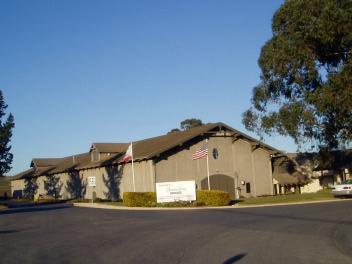
Today there is a dramatic remaking of the
brand. Beam Wine Estates has contributed
the corporate financial backing that has
made it possible. The current CEO is production-
driven, but also quality-oriented.
The winemaking facility (pictured right) was
built in the 1970s, one of the first wineries in
Carneros. It has been completely modernized
and now contains 62 5 to 10 ton open-top
fermentors which have been installed in the
former barrel room. This gives the winery
the capability to have all of the wine from the
estate, which arrives usually over a two week
period, fermenting in unison. The Ramal
vineyard is undergoing replanting with
different rootstocks and clones matched to
suitable sites on the estate property. The East Ramal Vineyard has 3 to 9 year old vines of Chardonnay,
Syrah, Pinot Gris, Merlot, and Pinot Noir. The West portion of Ramal Vineyard is mostly all new
plantings, expected to deliver fruit in 2006 for the first time. Here there is Chardonnay, Merlot, Syrah,
and Pinot Noir. The vineyards are pictured and Clonal Maps of the vineyard are depicted on the next
pages. Pommard is the workhorse clone here with other clones adding interest such as 115 (spice),
667 (structure), 777, 828, 583 (cherry) and Swan. They all contribute something to the mix. There are
a total of 167 different blocks on the property, in essence, many different small vineyards within a
large vineyard. Out of a total of 1,000 acres, 800 are planted or replanted and the last phases of replanting
will be completed in 2008. Sophisticated viticulture technology is now employed including
airplane-view (called “Vine View”) infrared mapping of vine vigor which can be used to guide
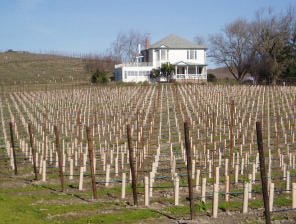
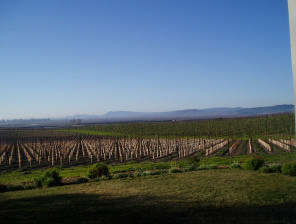
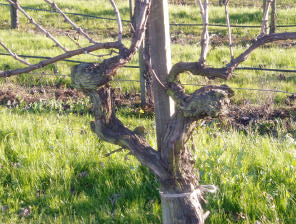
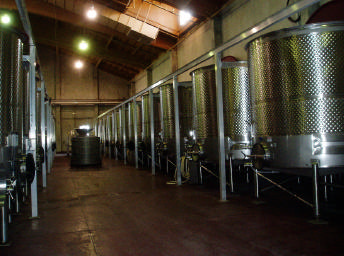
Top (ascending): new plantings, Buena Vista House for guests in background; view of new plantings
looking southeast toward San Pablo Bay; Old vine; Bottom: fermentation tank room.
irrigation and picking. Better trellising and spacing of vines has been employed to stimulate balance
and intensity. The emphasis is on farming for balance and quality now with lower yields in all vineyards
(many blocks below 3 tons per acre), use of deficit watering regimes to create smaller berries,
and the planting of natural cover crops to soak up water and add organic material to the soils. The current
vineyard manager, Craig Weaver, is a Ohio native who has spent over 20 years managing vineyard
sites in California.
Jeff Stewart arrived at Buena Vista in 2003 after crafting cool-climate varietals at La Crema Winery in
the Russian River Valley for five vintages. Prior to that, he made wine at Robert Keenan, Laurier, De
Loach, Mark West and Kunde. Noted winemaker Chuck Ortman was one of his earliest mentors. Jeff
grew up in the Lake Tahoe area of California. His high school chemistry teacher encouraged him to go
into winemaking after a trip to France in high school sparked his interest in wine. It was a bottle of
1978 Romanee-Conti that convinced him to make Pinot Noir. Jeff is like a big friendly bear - a burly
guy with a winning smile and an unrelenting enthusiasm for his work. His mantra is balance and he
says, “As with many winemakers, I believe in balance, both in the vineyard and in the wines. I like to
see power and elegance working together.” In early 2004, Jeff and the Beam Estates management
team headed by Jim DeBonis, made the decision to discontinue the previous California Classic and
Grand Reserve lines of wines, and reduce production to 45,000 cases. The two new lines of wines include:
The Carneros Series, varietal bottlings of Chardonnay, Merlot, Pinot Noir and Syrah ($19-$21)
and The Estate Vineyard Series (EVS) of limited release wines featuring select clonal material and/or
blocks from the property ($37). New packaging and labeling create a modern and sophisticated tone.
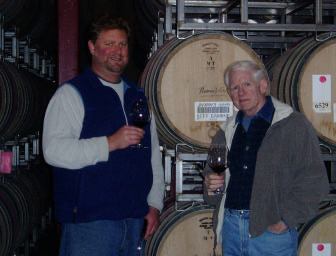
The grapes here are picked in early morning hours, starting at 2:00 AM and finishing by 8:00 AM. The
cold fruit that is brought in is fresh and sugars are slightly less than at mid-day. Intensive sorting is
followed by de-stemming. Fermentation is carried out with both native and commercial yeasts. A
Revinsa basket press is used to gently draw off the juice. All of the blocks are aged separately using
about 35% new oak (mostly French, some Eastern European). Currently there are 20 clones of Pinot
Noir on 40 blocks across 180 acres.
I recently had the opportunity to sample several of the latest releases of Pinot Noir. There is tremendous
potential here because of the vast vineyard acreage upon which to draw. With the infusion of
modern farming technology and skilled winemaking, the future looks very promising. By 2006, only
40% of the vineyards were producing fruit so the wines tasted below only hint at the future quality of
the wines to come. All of the wines have nice finesse and weight. There is no t n ‘a overload and the wines are nicely balanced. Mouth feel is particularly attractive. Once Jeff has all of the right
grapes to work with, his ducks in line as they say, Buena Vista Pinot Noirs will be on every pinotphile’s
want list. Agoston Hereszthy would have been proud.
2009 Brooks Willamette Valley Pinot Noir
14.3% alc., 2,600 cases, $22. 9 vineyard sources. Grapes were
100% de-stemmed and fermented in individual lots. Aged 10 months in 35% new French oak with some
Hungarian oak. Unfined and unfiltered.
·
Moderately light reddish-purple color in the glass. Initially the nose
offers demure but satisfying aromas of red cherries and berries, dried rose petals and a hint of baking spice.
The aromatic intensity fades over time in the glass with a touch of alcohol rearing up. Medium-weighted red
fruit flavors with a nice smack of cherry on the finish. Very soft tannins and a smooth mouth feel make for easy
approachability. A fruit-forward wine offering a glimpse of the 2009 vintage in Oregon which offers more
upfront charm than the 2008 vintage and higher alcohols. Good.
2005 Buena Vista Carneros Ramal Vineyard Pinot Noir
13.5% alc., $25.
·
A light style of Pinot Noir that takes
on a fuller structure with time in the glass. Attractive cherry, toast
and smoke notes are featured in the aromas and flavors. A thoroughly
satisfying daily drinker.
2004 Buena Vista Carneros Ramal Vineyard Pinot Noir
13.5%
alc. 14,000 cases, $23.
·
An elegant style that is driven by cherries
and strawberries in the nose and flavors. A little smokiness and
herbs add interest to the nose and finish. This wine has a fairly rich
mouth feel. With air time, the wine becomes quite silky and more
fruity.
Buena Vista Carneros has a tasting room in the original winery stone press house (pictured below),
located five minutes from the Sonoma Plaza Square. It is open from 10-5 daily and the phone is 800-
926-1266. You can drive out onto Ramal Road and see the Ramal Vineyard and Buena Vista winery, but
tours here are by appointment. The 2005 Carneros Pinot Noir was released in December, 2006, but the
other 2005 Pinot Noirs are not available as yet. The winery website is www.buenavistacarneros.com.
Wines may be purchased on the website or through fine wine retail channels.